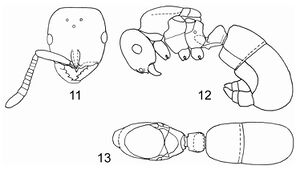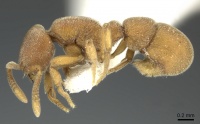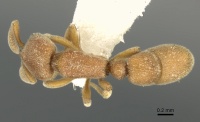Proceratium zhaoi
| Proceratium zhaoi | |
|---|---|

| |
| Scientific classification | |
| Kingdom: | Animalia |
| Phylum: | Arthropoda |
| Class: | Insecta |
| Order: | Hymenoptera |
| Family: | Formicidae |
| Subfamily: | Proceratiinae |
| Tribe: | Proceratiini |
| Genus: | Proceratium |
| Species: | P. zhaoi |
| Binomial name | |
| Proceratium zhaoi Xu, Z., 2000 | |
| Synonyms | |
| |
Specimens have been collected in the soil in deciduous broad-leaf forest while others were found on a forested slope in a river valley.
This species is only known from two locations at mid-elevation in forests of southern and western Yunnan Province. The original description reported 45 workers in the type colony (Xu 2000) and no other data on natural history have been published. However, the relatively short legs suggest a purely hypogeic life style, which conforms to the fact that specimens were extracted from soil samples.
Identification
The new species is close to Proceratium itoi, but occipital margin straight, frontal carinae suberect and without laterally expended frontal lobes, mandible with 4 teeth, subpetiolar process large and roughly rectangular, body smaller. (Xu 2000)
Staab et al. (2018) - A member of the Proceratium itoi clade. Proceratium zhaoi differs from the other members of its clade by the following character combination: small species (TL 2.0–2.8, WL 0.66–0.80; measurements and indices use data from the original descriptions); of head weakly convex, broadest at level of eyes and gently narrowing anteriorly and posteriorly, posterior head margin weakly concave to almost straight; frontal carinae developed, their lateral lamellae relatively narrow, not extending over antennal insertions; posterodorsal corners of propodeum bluntly angled; posterior face of petiolar node, in profile, shorter and steeper than anterior face, dorsum of node broadly rounded, petiole as long as broad or broader than long (DPeI 98–110), subpetiolar process developed, relatively variable, varying in size and shape (from rectangular to triangular to acutely toothed); only dense pubescence, no erect hairs on dorsum of body, head, and scapes.
Despite some size variation (TL 2.0–2.8), the relative body proportions of Proceratium zhaoi are constant (CI 84–90, SI 61–66). Proceratium zhaoi is the smallest (WL 0.66–0.80) member of the Proceratium itoi clade. It can be distinguished from all other Proceratium itoi clade species (except for Proceratium williamsi) by the absence of erect hairs that protrude through the dense pubescence on the dorsal body surface. Proceratium williamsi also lacks hairs on the dorsal body surface, but is larger (WL 0.80–0.92), has stronger developed frontal carinae and relatively more slender and longer legs. The relatively weakly developed frontal carinae and the short legs (MFeI <80, MTiI <65, MBaI <40) make Proceratium zhaoi also unique among the Chinese Proceratium itoi clade species.
Volumetric raw data (in DICOM format), a 3D rotation video (in .mp4 format, see Suppl. material 6: Video 4), still images of surface volume rendering, a 3D surface (in PLY format), and montage photos illustrating the head, profile and dorsal views of the body of a paratype of Proceratium zhaoi (CASENT07900671) and a paratype of Proceratium nujiangense (CASENT0790672) were all generated as part of this study (Staab et al 2018). Data and images are freely available for download from a Dryad repository (there is a download link at the top right of the webpage) and a 3D surface model can be viewed online at Sketchfab: CASENT07900671, CASENT07900672.
Keys including this Species
Distribution
Latitudinal Distribution Pattern
Latitudinal Range: 22.185° to 22.185°.
| North Temperate |
North Subtropical |
Tropical | South Subtropical |
South Temperate |
- Source: AntMaps
Distribution based on Regional Taxon Lists
Palaearctic Region: China (type locality).
Distribution based on AntMaps
Distribution based on AntWeb specimens
Check data from AntWeb
Countries Occupied
| Number of countries occupied by this species based on AntWiki Regional Taxon Lists. In general, fewer countries occupied indicates a narrower range, while more countries indicates a more widespread species. |

|
Estimated Abundance
| Relative abundance based on number of AntMaps records per species (this species within the purple bar). Fewer records (to the left) indicates a less abundant/encountered species while more records (to the right) indicates more abundant/encountered species. |

|
Biology
Castes
Worker
 X-ray micro-CT scan 3D model of Proceratium zhaoi (worker) prepared by the Economo lab at OIST.
X-ray micro-CT scan 3D model of Proceratium zhaoi (worker) prepared by the Economo lab at OIST.
See on Sketchfab. See list of 3D images.
 X-ray micro-CT scan 3D model of Proceratium zhaoi (worker) prepared by the Economo lab at OIST.
X-ray micro-CT scan 3D model of Proceratium zhaoi (worker) prepared by the Economo lab at OIST.
See on Sketchfab. See list of 3D images.
 Staab et al. 2018. Figure 16. Still images from surface display volume renderings of 3D model of Proceratium zhaoi paratype worker (CASENT0790671). A Body in profile B Body in dorsal view C Head in dorsal view D Head in anterodorsal view E Head in anterior view F Head in ventral view G Head in profile H Mesosoma in profile I Mesosoma in dorsal view J Propodeum in posterodorsal view K Abdominal segment II and parts of III in profile L Abdominal segment II and parts of III in dorsal view M Abdominal segments II–VII in profile N Abdominal segment III and parts of II and IV in dorsal view O Abdominal segments II–VII in ventral view. |
 Staab et al. 2018. Figure 17. Still images from surface display volume renderings of 3D model of Proceratium zhaoi, a paratype worker of the synonymized P. nujiangense (CASENT0790672). A Body in profile B Body in dorsal view C Head in dorsal view D Head in anterodorsal view E Head in anterior view F Head in ventral view G Head in profile H Mesosoma in profile I Mesosoma in dorsal view J Propodeum in posterodorsal view K Abdominal segment II and parts of III in profile L Abdominal segment II and parts of III in dorsal view M Abdominal segments II–VII in profile N Abdominal segment III and parts of II and IV in dorsal view O Abdominal segments II–VII in ventral view. |
Queen

| |
| . | |
Nomenclature
The following information is derived from Barry Bolton's Online Catalogue of the Ants of the World.
- zhaoi. Proceratium zhaoi Xu, 2000c: 435, figs. 3-10 (w.q.) CHINA (Yunnan).
- Type-material: holotype worker, 6 paratype workers, 24 paratype queens.
- Type-locality: holotype China: Yunnan Prov., Menghai County, Meng’a Town, Papo Village, 10.ix.1997, soil sample, deciduous broadleaf forest, No. A97-2338 (Z. Xu); paratypes: 1 worker with same data, 5 workers, 24 queens with same data but No. A97-2380.
- Type-depository: SFCY.
- Status as species: Xu, 2006: 153 (in key); Zhou & Ran, 2010: 111; Guénard & Dunn, 2012: 62; Staab, et al. 2018: 164 (redescription).
- Senior synonym of nujiangense: Staab, et al. 2018: 164.
- Distribution: China.
- nujiangense. Proceratium nujiangense Xu, 2006: 153, figs. 8-13 (w.q.) CHINA (Yunnan).
- Type-material: holotype worker, 7 paratype workers, 10 paratype queens.
- Type-locality: holotype China: Yunnan, Baoshan City, Lujiang Town, Bawan, 1500 m., 11.viii.1998, No. A98-1964, Pinus yunnanensis forest, E slope of Nujiang River Valley (Q. Long); paratypes: 3 workers, 1 queen with same data, 1 worker with same data but A98-1995, 9 queens with same data but A98-1997, 1 worker with same data but A98-2010, 1 worker with same data but A98-2016, 1 worker with same data but A98-2029.
- Type-depository: SFCY.
- Status as species: Zhou & Ran, 2010: 111; Guénard & Dunn, 2012: 62.
- Junior synonym of zhaoi: Staab, et al. 2018: 164.
Unless otherwise noted the text for the remainder of this section is reported from the publication that includes the original description.
Description
Proceratium zhaoi
Worker
Holotype. TL 2.4, HL O.62, HW O.52, CI 84, SL O.34, SI 65, PW O.38, AL 0.70, ED 0.03, ML 0.30, PL 0.22, DPW 0.23, PH 0.28. Head roughly rectangular, slightly longer than broad and slightly narrowed forward. Occipital margin straight, occipital corners rounded. Lateral side weakly convex. Frontal carinae suberect, without laterally expended frontal lobes. Antennal sockets completely exposed. Anterior margin of clypeus with a triangular projection in the middle. Mandible with 4 teeth. Antenna stout, apex ofscape reaching to 112 of the distance from antennal socket to occipital corner, segments 3-11 broader than long. Eye minute, with only 1 facet. In profile view dorsum of alitrunk complete and weakly convex, lowed down backward, without sutures. Posterodorsal corner of propodeum bluntly angled, without tooth, declivity depressed. Metapleural lobe rounded at apex. In profile view petiolar node thick, narrowed upward and inclined backward, anterior and dorsal faces weakly convex, anterodorsal corner higher than posterodorsal corner. Subpetiolar process large and roughly rectangular, with a posteriorly pointed tooth. In dorsal view petiolar node transverse and broader than long, narrowed forward. Mandibles finely and longitudinally striate. Head, alltrunk, petiole and gaster finely and densely punctured, relatively dim. Head, body and appendages with dense decumbent pubescence, but without hairs. Body in color yellowish brown.
Paratypes. TL 2.0-2.5, HL O.60-0.64, HW O.52-0.56, CI 86-90, SL O.32-0.34, SI 61-65, PW 0.34-0.38, AL 0.66-0.74, ED 0.02-0.03, ML 0.28-0.34, PL 0.20-0.24, DPW 0.22-0.26, PH O.26-0.30 (n = 6). As holotype, but subpetiolar process rectangular to triangular.
Queen
Paratypes. TL 3.0-3.3, HL O.70-0.72, HW O.60-0.64, CI 86-89, SL O.36-0.38, SI 58-61, PW 0.48-0.50, AL 0.94-1.00, ED 0.12-0.14, ML 0.30-0:38, PL 0.24-O. 32, DPW O.26-0.30, PH O.34-0.40 (n = 5). As holotype worker but body much larger. Occipital margin slightly emarginate. Eyes large, with ocelli. Alitrunk massive and winged, dorsum weakly convex. Propodeum with a pair of blunt teeth. Subpetiolar process triangular. Body in color yellowish brown, eyes and ocellar area black.
Type Material
Holotype worker, No.A97-2338, 1280 m, Papo Village, Meng' a Town, Menghai County, Yunnan Province, collected in a soil sample in deciduous broad-leaf forest, 10. IX. 1997. (XU Zheng-Hui). Paratypes 1 worker, with same data as holotype; 5 workers and 24 alate females, with same data as holotype but No. A97-2380, collected from a nest which containing 45 individuals in a soil sample.
Etymology
This new species is named after Mr. ZHAO Qing-Shan (South Institute of Forest Plant Quarantine, Department of Forestry of China, Yiyang, Jiangxi Province) for his contribution in translation "The Fauna of British India Including Ceylon and Burma. Hymenoptera. Volume II. Ants and Cuckoo-wasps" from English into Chinese for the Chinese readers.
Proceratium nujiangense
Worker
Holotype. (Figs. 8-10). TL 2.5, HL 0.62, HW 0.55, CI 89, SL 0.35, SI 64, ML 0.30, ED 0.02, PW 0.38, AL 0.70, PL 0.22, PH 0.25, DPW 0.27. Head nearly square, slightly longer than broad. In full face view, occipital margin straight, occipital corners roundly prominent, lateral sides of head moderately convex. Masticatory margins of mandibles with 4 teeth, which reduced in size from apex to base. Anterior margin of clypeus with a narrow acute central projection. Antennae with 12 segments. Apices of scapes reach to 3/5 of the distance from antennal socket to occipital corner. Eyes minute, with 1 facet. In profile view, dorsum of alitrunk complete and straight, pronotum and propodeum convex, promesonotal suture and metanotal groove vanished on dorsal face. Posterodorsal corner of propodeum extrudent and bluntly angled. Lateral lobes of propodeum rounded. Petiolar node nearly triangular, anterior face long, straight and slope-like, dorsal face roundly convex, posterior face short and straight. Subpetiolar process short and small, nearly triangular. Constriction be narrow. Second gastral segment very large, gastral segments 3-5 small. Sting extrudent.
Mandibles coarsely and longitudinally striate. Head, alitrunk, petiole and gaster densely and finely punctate, dull. The whole body with dense decumbent short pubescence, dorsal face of body without erect hairs. Mandibles, anterior margin of clypeus and ventral face of body with sparse erect hairs. The whole body brown. Eyes grey. Terminal segment of antenna brownish yellow.
Paratype. Measurements in order minimum to maximum, arithmetic means in parentheses. TL 2.4-2.8 (2.5), HL 0.62-0.68 (0.64), HW 0.53-0.62 (0.56), CI 86-90 (87), SL 0.33-0.38 (0.35), SI 61-66 (63), ML 0.30-0.37 (0.32), ED 0.02 (0.02), PW 0.37-0.43 (0.40), AL 0.70-0.80 (0.74), PL 0.23-0.28 (0.26), PH 0.23-0.30 (0.26), DPW 0.25-0.30 (0.26) (7 individuals measured).
Queen
Paratypes. (Figs. 11-13). Measurements in order minimum to maximum, arithmetic means in parentheses. TL 3.1-3.3 (3.2), HL 0.70-0.72 (0.70) HW 0.62-0.63 (0.62), CI 86-90 (88), SL 0.37-0.40 (0.39), SI 58-65 (63), ML 0.33-0.37 (0.35), ED 0.12-0.15 (0.14), PW 0.47-0.52 (0.49), AL 0.97-1.03 (0.99), PL 0.30-0.33 (0.32), PH 0.30-0.32 (0.31), DPW 0.30-0.32 (0.31) (10 individuals measured). Similar to holotype, but body much larger. Eyes normal, vertex with 3 ocelli. Alitrunk thick and massive. Posterior margin of pronotum deeply emarginate. Anterior scutum of mesonotum very large, lateral scutum small and triangular, scutellum fan-like. Both mesonotum and metanotum with pteralia, lateral side with a distinct oblique furrow. Posterodorsal corner of propodeum bluntly angled. Body brown. Eyes, ocellar area and pteralia black.
Type Material
Holotype. China: Yunnan Province, Baoshan City, Lujiang Town, Bawan, Pinus yunnanensis forest on east slope of Nujiang River Valley, 1500 m, 11.VIII.1998, leg. Qizhen Long, No. A98-1964. Paratypes. Same data as holotype, 3 workers and 1 gyne; same data as holotype but No. A98-1995, 1 worker; same data as holotype but No. A98-1997, 9 gynes; same data as holotype but No. A98-2010, 1 worker; same data as holotype but No. A98-2016, 1 worker; same data as holotype but No. A98-2029, 1 worker.
References
- Liu, C., Fischer, G., Hita Garcia, F., Yamane, S., Liu, Q., Peng, Y.Q., Economo, E.P., Guénard, B., Pierce, N.E. 2020. Ants of the Hengduan Mountains: a new altitudinal survey and updated checklist for Yunnan Province highlight an understudied insect biodiversity hotspot. ZooKeys 978, 1–171 (doi:10.3897/zookeys.978.55767).
- Staab, M., Hita Garcia, F., Liu, C., Xu, Z.-H., Economo, E.P. 2018. Systematics of the ant genus Proceratium Roger (Hymenoptera, Formicidae, Proceratiinae) in China – with descriptions of three new species based on micro-CT enhanced next-generation-morphology. ZooKeys 770: 137–192 (doi: 10.3897/zookeys.770.24908).
- Xu, Z.-H. 2000c. A systematic study of the ant genus Proceratium Roger from China (Hymenoptera: Formicidae). Acta Zootaxon. Sin. 25: 434-437 (page 435, figs. 3-10 worker, queen described)
References based on Global Ant Biodiversity Informatics
- Fontanilla A. M., A. Nakamura, Z. Xu, M. Cao, R. L. Kitching, Y. Tang, and C. J. Burwell. 2019. Taxonomic and functional ant diversity along tropical, subtropical, and subalpine elevational transects in southwest China. Insects 10, 128; doi:10.3390/insects10050128
- Guénard B., and R. R. Dunn. 2012. A checklist of the ants of China. Zootaxa 3558: 1-77.
- Staab M., F. Hita Garcia, C. Liu, Z. H. Xu, and E. P. Economo. 2018. Systematics of the ant genus Proceratium Roger (Hymenoptera, Formicidae, Proceratiinae) in China – with descriptions of three new species based on micro-CT enhanced next-generation-morphology. ZooKeys 770: 137-192.
- Xu Z. H. 2000. A systematic study of the ant genus Proceratium Roger from China (Hymenoptera: Formicidae). Acta Zootaxonomica Sinica 25(4): 434-437.
- Xu Z. 2000. A systematic study of the ant genus Proceratium Roger from China (Hymenoptera: Formicidae). Acta Zootaxonomica Sinica 25(4): 434-437.


